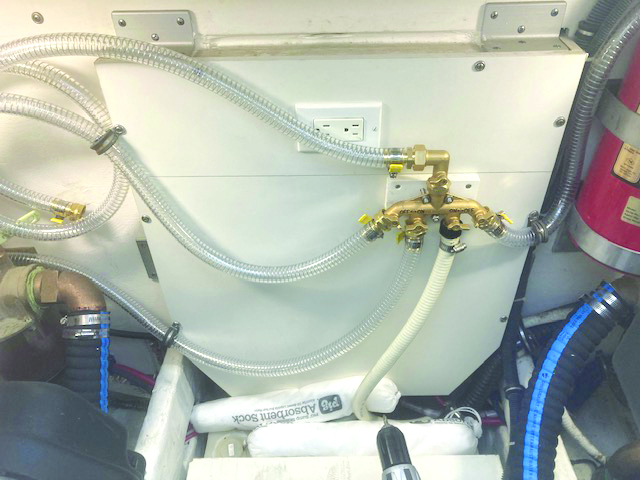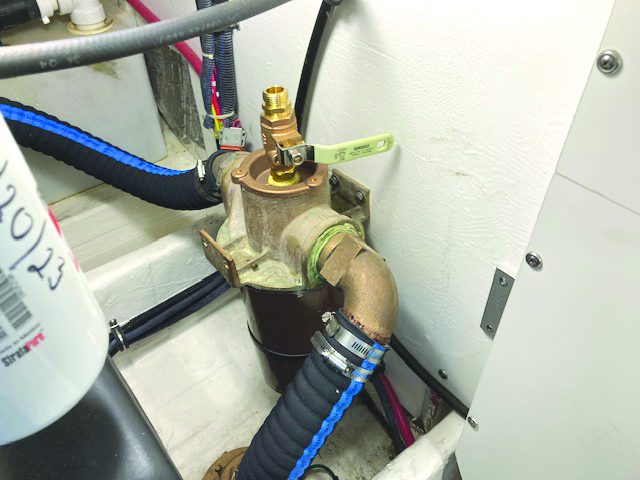Over the years I have had the pleasure of having to winterize many different boat systems and engines: inboards, outboards and inboard/outboards, fresh water, salt water, sanitation and air conditioning/ heating systems. The majority of the workboats I maintained had only the engines to worry about. The bigger diesel boats, like the forty-one foot U.S. Coast Guard boat, and sixty-foot crew boats all had engine block and cabin heaters to keep them warm and ready for service at all times.
It wasn’t until we bought our first boat that I had to really tackle the engines plus all the systems that go with a modern pleasure boat. And one big difference between a pleasure boat and a work boat is space. Most of the work boats I took care of had plenty of room for maintenance work. You could sleep in some of those engine rooms. On the boats I have owned, I had to be a contortionist! In time I learned how to get the job done on our boats by experience and gathering any tool or piece of equipment or hardware to make the job not only easier but possible! Wouldn’t you like to see the people who design some of these boats have to maintain them?

Our last boat was a thirty-foot twin diesel-powered express boat. It had a very tight engine room that I needed to get to the forward bulkhead of to gain access to the air conditioner seawater strainer. By removing the strainer top I would then install a flush-out cap and run a hose back to the raw water wash-down pump. That pump had a quick disconnect suction line on it that I could replace with a hose that had the other end in a bucket of non-toxic anti-freeze. I could then use it to force anti-freeze through the air conditioning system to purge all the sea water and protect it with the anti-freeze. I was able to do that for all of the systems on the boat except for the main engines.
Those were actually fairly easy to winterize. Each engine had a sea strainer at the rear bulkhead, right where the engine hatch opened to its widest point. I would remove the top of each strainer and replace it with a flush-out adapter. That adapter would have a three-quarter inch suction hose attached to it with the end placed in a large bucket between the two engines. The bucket held close to three gallons of anti-freeze. I could start up one engine and watch the bucket as the engine’s raw water pump pulled out the anti-freeze. When it got low, maybe an inch from the bottom, I would shut off the engine and refill the bucket. It would take roughly six gallons until I saw solid pink anti-freeze coming out of the exhaust. I would repeat the process for the other engine and when I was all done, I would remove the batteries, have the boat shrink-wrapped and enjoy the winter.

Our new boat is basically a larger version of the last, thirty-six feet long with twin diesels and a generator. The engine room has slightly more room but it is set up differently. The main engine sea strainers are placed in front of each engine. The generator sea strainer is at the rear of the engine room, hiding under a six-inch exhaust pipe running aft. Gaining access to these is not the easiest, so I came up with a solution to help winterize and allow me to fresh water flush the engines and generator fairly easily
I wanted to be able to flush out the engines and generator easily after each use as well as winterize them. A friend of mine down in Florida had the exact boat I had sold and put in a system similar to what I wanted. I just had to perfect it for use in this boat. I already had one flush-out cap for the main engine, so I purchased another for one main and another smaller one to fit the generator sea strainer. Each one of those has a three-quarter inch garden hose fitting on it, so that was a good starting point. I knew I needed a central location that was easily accessible for me. Searching in local hardware stores I came close to finding a manifold that would do the trick but they all had plastic handles on the ball valves. Then while online, I found one with brass handles that was exactly what I wanted.
After getting the manifold, twenty-five feet of three-quarter inch inside diameter suction hose and all the other hardware I made a block to mount the manifold and installed it on the forward bulkhead in a spot I could get to. Once that was mounted, everything went fairly quickly. I ran the hoses and connected them to the manifold and the flush-out caps. That accounted for three of the hose connections on the manifold. Another went to a suction hose straight down into the bilge. I can use that to remove any small amounts of water that accumulate in the forward engine room. But the primary use for that hose will be to use as a suction hose pulling anti-freeze from a bucket into all the engines (one at a time) for winterization. The last hose connection is a garden hose attachment to flush out the engines at the dock.
When it was all done, I put it to the test the third week of October. I have to say it did work very nicely and helped move the job along quickly. I ran ten gallons of non-toxic (pink) anti-freeze through each main engine. The generator took another six gallons.
The rest of the systems went quickly also. I opened every faucet to drain the seventy-gallon fresh water tank and six-gallon water heater. Then I hooked up my small compressor to the dockside water hook up on the boat and blew out any of the water remaining. The hot water tank has a pair of bypass valves that once closed keep the non-toxic anti-freeze out so you don’t need to run another six gallons through it. It has a drain valve that would drain into the engine room. The hose for that fits nicely into a two-liter soda bottle and that is what I used to get any remaining water out from the water heater. I poured ten gallons of the non-toxic anti-freeze into the water tank and then with the water pump on, opened each faucet one at a time until I had solid pink coming out. That would also drain into each drain box for the shower or sinks and protect them from freezing.
The last two systems to take care of were the air conditioning and raw water wash-down. That was easy and all I had to do was remove the suction hose from the thru-hull valve and stick it in a bucket of anti-freeze. With the wash-down hose attached, I turned on the raw water pump and blew the anti-freeze through the wash-down pump and hose. I then connected the wash-down hose to the air conditioning sea strainer flush-out cap and again turned on the wash-down pump. A few gallons later I had solid pink flowing from the air conditioning discharge, good to go!
The only thing I did different this year was not removing the batteries, all five of them. I ran out of time and they are in a tough spot to get to. I made sure they were charged up and the electrolyte was at the full level. Before the boat was wrapped, I ran the shore tie out the scupper and stowed the end on the rudder, out of the weather. Once a month I go out and plug it into an outlet for a few days to keep the batteries charged.
Link to flush out system video on YouTube:https://www.youtube.com/watch?v=SA6yV-hcjDI&t=34
